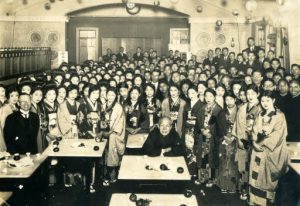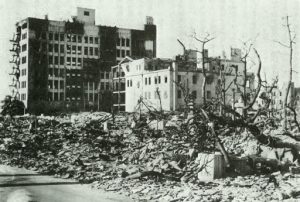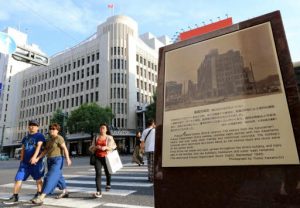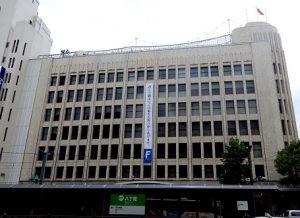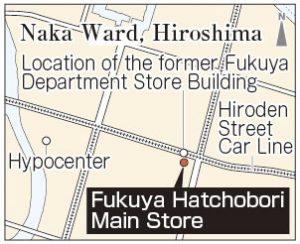Fukuya Hatchobori Main Store to display A-bombed exterior wall: Witness to tragedy and restoration in Hiroshima
Sep. 2, 2019
Department store reopened at the ruined building’s site in January, 1946
by Miho Kuwajima, Staff Writer
Fukuya, a department store located in Naka Ward, Hiroshima, has played a central role in the Hatchobori and Kamiya-cho areas since before the war, and is a fixture in what is the largest and busiest shopping district in the Chugoku and Shikoku regions. A bustling area with movie theaters and shops long before the outbreak of war, both Hatchobori, and Fukuya were devastated when an atomic bomb was dropped by U.S. forces in August of 1945.
This year, on October 1, Fukuya will begin to exhibit pieces of its original A-bombed exterior store wall in conjunction with its 90th anniversary. The wall, along with other items, will be placed on permanent display at the Fukukya Hatchobori Main Store. The building itself has been continuously and carefully used since the atomic bombing, and the exhibit is a new initiative aimed at sharing the history of downtown Hatchobori with future generations.
Fukuya opened its Fukuya Hatchobori store in April, 1938. At that time, because such a large concrete building (with eight floors above ground and two underground) was rare, it became popular among citizens, who began to refer to it as “White Grand Palace.” Superior materials and design were used in constructing the building, and exterior terracotta pieces believed to have been part of the second floor or above, will be on display.
According to a book highlighting the 50-year history of Fukuya Co., Ltd. (published in 1980), people were so drawn to the store upon it’s opening that a policeman had was on site to direct traffic. Kazuhiko Takano, 63, a director of the Hiroshima City Museum of History and Traditional Crafts in Minami Ward, explained, “Once street cars began operation in 1912, the main shopping area gradually shifted from the former Nakajima district to Hatchobori. Then, as a result of the opening of Fukuya, the downtown area in Hiroshima developed a presence that could compete with other big cities in Japan.”
In a photo donated this past July by the family of a former Fukuya employee, it’s easy for one to envision what the Fukuya Department Store was like during that era. The photo shows people gathered for a New Year’s party held in the old Fukuya building. That structure once stood in front of what is now the Hatchobori Main Store. In the photo, taken around 1930, one can glance women clad in their best kimonos, and seemingly quite proud and excited to be at their place of work—a dream workplace for many at the time.
The store’s fate, however, would soon be overshadowed by war. When the Pacific War broke out, most of the department store’s interior space was utilized by the military and other organizations, and its external walls were painted in camouflage to avoid being bombed. The day of the atomic bombing, the store’s interior was entirely destroyed. Because the bomb was dropped prior to opening its doors for business, hardly any employees were at work in the building. However, also located within the building were the offices of Hiroshima Chokin Bank and the Chugoku Shipping Bureau. The bombing killed many of the officers and mobilized students who were already at work within these offices.
Though the entire Hatchobori area was destroyed, a newly constructed wing of the Fukuya building, which had been strongly built, managed to avoid collapse, and when the war came to a close, the store’s employees returned to restore Fukuya completely of their own means. They started off by selling sake in milk bottles on what was left of the first floor of the building in January the following year, and rebuilt the store meter by meter over time.
Eighty-one years have passed since the Fukuya Hatchobori Main Store was built in Hatchobori, and ever since, store presidents have consistently followed the policy of using the building carefully and continuing with its upkeep and repair.
At present, eighty-five A-bombed buildings remain in Hiroshima but only eight are owned by private companies—Fukuya Hatchobori Marin Store and the Hiroshima Electric Railway Sendamachi Substation in Naka Ward are two examples. The Hiroshima Andersen building, once a symbol for all A-bombed structures is now being reconstructed. As a result, Fukuya Hatchobori Main Store will become an even greater reflection of the city’s past, as it has essentially remained unchanged since the pre-war period.
(Originally published on September 2, 2019)
by Miho Kuwajima, Staff Writer
Fukuya, a department store located in Naka Ward, Hiroshima, has played a central role in the Hatchobori and Kamiya-cho areas since before the war, and is a fixture in what is the largest and busiest shopping district in the Chugoku and Shikoku regions. A bustling area with movie theaters and shops long before the outbreak of war, both Hatchobori, and Fukuya were devastated when an atomic bomb was dropped by U.S. forces in August of 1945.
This year, on October 1, Fukuya will begin to exhibit pieces of its original A-bombed exterior store wall in conjunction with its 90th anniversary. The wall, along with other items, will be placed on permanent display at the Fukukya Hatchobori Main Store. The building itself has been continuously and carefully used since the atomic bombing, and the exhibit is a new initiative aimed at sharing the history of downtown Hatchobori with future generations.
Fukuya opened its Fukuya Hatchobori store in April, 1938. At that time, because such a large concrete building (with eight floors above ground and two underground) was rare, it became popular among citizens, who began to refer to it as “White Grand Palace.” Superior materials and design were used in constructing the building, and exterior terracotta pieces believed to have been part of the second floor or above, will be on display.
According to a book highlighting the 50-year history of Fukuya Co., Ltd. (published in 1980), people were so drawn to the store upon it’s opening that a policeman had was on site to direct traffic. Kazuhiko Takano, 63, a director of the Hiroshima City Museum of History and Traditional Crafts in Minami Ward, explained, “Once street cars began operation in 1912, the main shopping area gradually shifted from the former Nakajima district to Hatchobori. Then, as a result of the opening of Fukuya, the downtown area in Hiroshima developed a presence that could compete with other big cities in Japan.”
In a photo donated this past July by the family of a former Fukuya employee, it’s easy for one to envision what the Fukuya Department Store was like during that era. The photo shows people gathered for a New Year’s party held in the old Fukuya building. That structure once stood in front of what is now the Hatchobori Main Store. In the photo, taken around 1930, one can glance women clad in their best kimonos, and seemingly quite proud and excited to be at their place of work—a dream workplace for many at the time.
The store’s fate, however, would soon be overshadowed by war. When the Pacific War broke out, most of the department store’s interior space was utilized by the military and other organizations, and its external walls were painted in camouflage to avoid being bombed. The day of the atomic bombing, the store’s interior was entirely destroyed. Because the bomb was dropped prior to opening its doors for business, hardly any employees were at work in the building. However, also located within the building were the offices of Hiroshima Chokin Bank and the Chugoku Shipping Bureau. The bombing killed many of the officers and mobilized students who were already at work within these offices.
Though the entire Hatchobori area was destroyed, a newly constructed wing of the Fukuya building, which had been strongly built, managed to avoid collapse, and when the war came to a close, the store’s employees returned to restore Fukuya completely of their own means. They started off by selling sake in milk bottles on what was left of the first floor of the building in January the following year, and rebuilt the store meter by meter over time.
Eighty-one years have passed since the Fukuya Hatchobori Main Store was built in Hatchobori, and ever since, store presidents have consistently followed the policy of using the building carefully and continuing with its upkeep and repair.
At present, eighty-five A-bombed buildings remain in Hiroshima but only eight are owned by private companies—Fukuya Hatchobori Marin Store and the Hiroshima Electric Railway Sendamachi Substation in Naka Ward are two examples. The Hiroshima Andersen building, once a symbol for all A-bombed structures is now being reconstructed. As a result, Fukuya Hatchobori Main Store will become an even greater reflection of the city’s past, as it has essentially remained unchanged since the pre-war period.
(Originally published on September 2, 2019)

